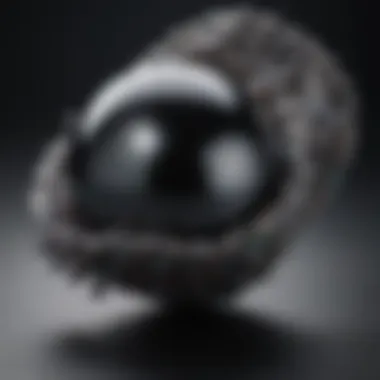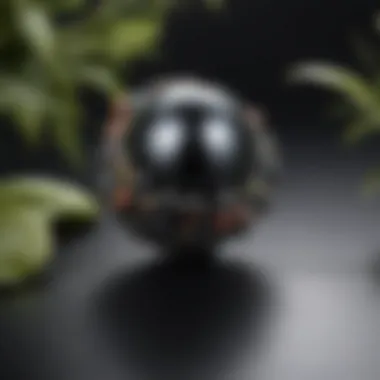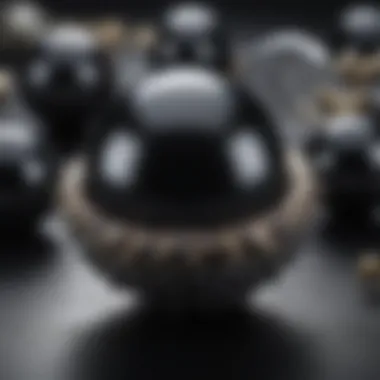The Intrinsic Value of Black Pearls: An In-Depth Analysis


Intro
Black pearls, the rare beauties of the ocean, carry a fascination that's hard to ignore. Many might see them as just another precious gemstone, but lurking beneath their lustrous surface is a world steeped in history, cultural significance, and a market that's as dynamic as it is intriguing. In this piece, we shall embark on a journey to unveil what really gives black pearls their worth. From their formation in the depths of the ocean to their captivating role in modern jewelry and wellness practices, this exploration is tailored for gemstone enthusiasts and potential buyers.
Gemstone Overview
Definition and Origins
Black pearls, primarily produced by the black-lipped oyster (Pinctada margaritifera), shine bright with a unique allure that differentiates them from their whiter counterparts. The distinctive color often derives from the oyster's environment and genetics. You might hear some refer to them simply as Tahitian pearls, because that's where most of them originate. However, their production is not confined to just the waters around Tahiti; other locations, like Fiji and the Cook Islands, also yield these treasures.
Historical Significance
Throughout history, black pearls have been shrouded in mystique. Long before they graced runways and red carpets, they captured the attention of royalty and the affluent. In ancient civilizations, they were regarded as symbols of wisdom, beauty, and even immortality. The Incans adorned their rulers with black pearls, thinking it bestowed strength. In contrast, European nobility often sought these rare gems in the 18th and 19th centuries, perceiving them as tokens of luxury and status.
"A pearl is a beautiful thing that is produced by an animal. It is a secret of nature, fashioned into joy." - Charles H. W. Dejust
Gemstone Properties
Hardness and Durability
When considering gemstones, their hardness is paramount, and black pearls are no exception. Scoring between 2.5 and 4.5 on the Mohs scale, they are relatively soft compared to some other gemstones. This means they require careful handling. With proper care, however, black pearls can maintain their beauty for generations. Their nacre, the inner shell layer of the oyster, contributes to their durability while also giving them that sought-after iridescence.
Color and Clarity
Rarity is a critical factor in what makes black pearls so enticing. Their colors range from deep black to shades of gray and even peacock green. The nuances in color often stem from the specific environmental factors where they are cultivated. Clarity is another consideration. Unlike diamonds, which are often judged by the absence of flaws, black pearls may have surface characteristics that actually enhance their uniqueness. Mottling and light blemishes are common but can add a certain top-notch charm that collectors appreciate.
Black pearls carry a complexity that draws the attention of many, whether they're casual admirers or seasoned collectors. Understanding the nuances behind their origins, properties, and historical weight can enrich one’s appreciation for these oceanic gems.
Understanding Black Pearls
Black pearls often spark a sense of curiosity and admiration. These unique gems, formed within mollusks, are not just mere adornments; they also hold a wealth of history and craftsmanship. Understanding black pearls is crucial for anyone interested in gemstone valuation, jewelry design, or simply appreciating their beauty. This section sets the groundwork for the discussion on intrinsic value, revealing the many layers that contribute to their allure.
Definition and Formation
Black pearls, quite distinct from any run-of-the-mill gemstone, emerge from a number of species of oysters and mussels, primarily in warm, tropical waters. They form over time when irritants such as a grain of sand or a parasite enter the shell of the mollusk. To protect itself, the mollusk secretes layers of nacre, the same substance that gives pearls their lustrous shine. This process, while fascinating, can take several years, leading to their status as precious gems.
Types of Black Pearls
Black pearls are categorized into several types, each possessing its own set of features and market appeal. Understanding these different types is essential for buyers and collectors.
Natural Black Pearls
Natural black pearls are a rarity. Formed without human intervention, they come solely from the natural processes of the ocean. The key characteristic of natural black pearls is their authenticity and unique imperfections; these traits appeal to purists and collectors. With their unpredictable shapes and varying quality, they are often seen as a more sustainable choice, even though they can come at a hefty price. One significant advantage is their irreplaceable status in the market. However, their scarcity can make them difficult to find, leading to a limited supply.
Cultured Black Pearls
On the other hand, cultured black pearls harness human ingenuity. Farmers introduce irritants into the mollusks, closely managing the conditions for growth. The defining feature of cultured black pearls is their controlled environment, which often results in better uniformity in size and color. Cultured black pearls are increasingly popular due to their accessibility and relatively lower price compared to natural counterparts. One downside, however, is that some purists may view these pearls as less authentic due to their farmed nature.


Hybrid Black Pearls
Hybrid black pearls are an interesting blend—crossbreeding between different mollusk species or combining the growth methods of cultured and natural pearls can produce hybrid varieties. They showcase a stunning array of characteristics, often displaying unique colors that set them apart in the jewelry market. This hybrid nature often leads to heightened interest from collectors who appreciate diversity in form and color. However, as with cultured varieties, their less natural origin can lead to debates about authenticity in the eyes of traditionalists.
"Black pearls are a testament to the complexity of natural beauty and human intervention, each type casting a different light on their intrinsic worth."
Understanding these types of black pearls paves the way for recognizing their significant value in the gem world. It sets the stage for further exploration into their characteristics, market dynamics, and cultural importance.
Characteristics of Black Pearls
Understanding the characteristics of black pearls is essential in grasping their true value. These traits not only contribute to their unique appeal but also influence their market demand and cultural significance. The nuances of color, luster, and surface quality can make all the difference when it comes to valuation and desirability. This section delves deep into these essential characteristics, providing insights into what makes black pearls so distinctive.
Color Spectrum and Variability
Shades of Black
When it comes to black pearls, the shades of black are remarkably diverse. From a deep charcoal to a lighter, almost grayish tint, each variation offers a unique perspective on what it means to be black. The richness of these hues contributes significantly to their overall aesthetic value. For collectors and enthusiasts alike, this variability can be a deciding factor in purchasing decisions.
This variability not only affects their appearance but also creates a compelling narrative. Sometimes a black pearl might appear to shimmer with elements of green, blue, or even purple underneath, making it an attractive option for those who appreciate depth in color. This optical phenomenon is due to the interplay of light and the specific thickness of the pearl's nacre.
Overtones and Orient
Beyond the primary shade, the overtones of black pearls play an integral role in their allure. Overtones are the subtle secondary colors that can be seen when viewing the pearl from various angles. A black pearl with a vivid green overtone may be more sought after than one that lacks it, as it adds a layer of complexity and sophistication. The orient, too, refers to the shimmering effect, which can make the pearl appear alive under the right light conditions. This refractive quality can be appealing to buyers looking for something that stands out in a unique way.
Luster and Surface Quality
Types of Luster
Luster is another pivotal characteristic that elevates the beauty of black pearls. There are generally two types of luster: metallic and satiny. A metallic luster, often seen in black Tahitian pearls, offers a high-shine quality that can mimic the sheen of precious metals. This type attracts those who look for jewelry that draws attention. In contrast, satiny luster provides a more subdued and refined glow, appealing to buyers who favor elegance over flash.
Each type has its own merits, and understanding these differences is crucial for anyone interested in acquiring black pearls. It's this interplay of surfaces that can influence a pearl's perceived value in the market.
Assessment of Surface Quality
Surface quality is yet another indicator of a pearl's value and desirability. When assessing surface quality, factors such as blemishes, irregularities, and smoothness come into play. Perfectly smooth pearls often command higher prices than those with visible imperfections. However, it’s worth noting that some collectors appreciate natural flaws as they can impart character and authenticity to the piece.
Being knowledgeable about luster and surface quality allows collectors to make informed choices when purchasing black pearls. It’s not just about looks; it’s also about understanding what the features convey about the pearl's origin and quality.
"Black pearls are not just a piece of jewelry; they embody a story that goes beyond their outer shell."
Market Dynamics
The world of black pearls is not just about their aesthetic appeal; it is also shaped by the dynamics of the market in which they reside. Understanding market dynamics helps in grasping how various factors influence the valuation and desirability of these unique gems. The interaction between rarity and demand plays a crucial role, as does the pricing, which is intricately linked to both the characteristics of the pearls and the trends in the jewelry industry.
Grasping market dynamics provides insight for gemstone enthusiasts, collectors, and jewelry designers. A foundational knowledge of these aspects is vital before investing in or designing with black pearls.
Rarity and Demand
Geographical Distribution


When we talk about the geographical distribution of black pearls, we quickly recognize its importance in determining their rarity. Black pearls mainly come from the Pinctada margaritifera oyster, predominantly found in the Tuamotu Archipelago of French Polynesia, with notable contributions from the Cook Islands and parts of Micronesia.
This unique characteristic sets them apart. The specific conditions in these regions, such as water temperature, salinity, and the availability of algae, allow for the formation of these extraordinary pearls. As a result, pearls originating from these areas hold a higher value due to their limited production, making them a preferred choice for collectors and designers alike.
The limited geographical areas producing black pearls can be an advantage but can also create challenges. For instance, if one of these locales experiences environmental issues, it can greatly reduce pearl availability, thus impacting their market value.
Collector Interest
Collector interest is another significant driving force in the market. Many collectors are drawn to black pearls because of their unique colors, shapes, and sizes—no two black pearls are exactly alike. This aspect only adds to their allure and fuels a robust market for these gems.
Collectors are often willing to pay a premium for exceptional pieces, especially those that exhibit rare features like unusual overtones or extraordinary luster. Special auctions and collector shows often showcase black pearls, further igniting interest and demand. However, this interest can also vary based on trends; collectors tend to gravitate towards specific characteristics at different times, which can lead to fluctuations in the market.
Pricing Factors
Size and Shape
The size and shape of black pearls are crucial in determining their market price. Generally, larger pearls are rarer and fetch higher prices. The ideal shapes—round, near-round, or drop-shaped—are highly sought after, while baroque shapes, though unique, may have varied appeal among buyers.
Notably, the dimensions of a pearl can communicate a status of luxury and sophistication, making it a relevant aspect for jewelry designers targeting upscale markets. However, there is also a niche for irregular or unconventional shapes that attract certain collectors, reflecting the diverse preferences within the market.
Market Trends
Market trends also play a significant role in the pricing of black pearls. Current jewelry trends can shift demand, impacting prices for different styles of black pearls. For instance, the rise of sustainable and ethical sourcing has made cultured black pearls increasingly popular, leading to a greater demand for ethically sourced products across the board.
In addition, seasonal trends can also influence popularity; for example, certain shades may be favored during specific seasons or fashion cycles. Understanding these trends can be instrumental for anyone looking to navigate the black pearl market successfully.
"The value of black pearls is a composite of rarity, quality, and the stories they tell."
This relationship between market dynamics, rarity, pricing factors, and collector interest encapsulates why black pearls hold such intrinsic value. Recognizing these components provides a clearer path for understanding black pearls, whether for personal investment, collection, or as design elements in jewelry.
Cultural Significance
The cultural significance of black pearls cannot be overstated. They symbolize wealth, beauty, and rarity across various societies. This part of the article digs deep into the importance of black pearls not only as luxury items but also as cultural artifacts that carry stories, traditions, and artistry. The allure of these gemstones transcends mere material value, inviting exploration into how they are interwoven with human lives, beliefs, and customs.
Historical Context
Mythology and Folklore
Mythology and folklore surrounding black pearls often portray them as treasures bestowed by the ocean. Different cultures have embedded stories that depict these gems as gifts from gods or remnants of mythical creatures. For instance, in Polynesian mythology, black pearls are linked to the legendary goddess of the sea, who is believed to have crafted these jewels from the depths of the ocean. This characteristic grants black pearls an aura of sacredness and immense cultural value. Such tales not only enchant gemstone enthusiasts but also serve as a bridge connecting modern individuals to historical beliefs and traditions.
In this article, discussing the mythology tied to black pearls deepens the reader's appreciation of their historical context, encouraging a more profound respect for these pearls as relics of ancient cultural narratives.
Symbolism in Different Cultures
From Asia to the Americas, black pearls carry varied symbolic meanings that enrich their worth. In some cultures, they represent prosperity and good fortune, while in others, they might symbolize wisdom and peace. The complexity of their symbolism is beneficial, as it adds layers to their value beyond aesthetics. For example, in Hawaii, black pearls are often associated with nobility and recognition. This unique feature captivates both collectors and the general public, revealing how black pearls evolve from mere jewel to cultural emblem.
Understanding the diverse symbolism surrounding black pearls allows readers to grasp how they are perceived globally, enhancing their appreciation of these gemstones.


Modern-Day Prevalence
Usage in Fashion
In the realm of fashion, black pearls have emerged as a statement piece, gracing collections in both high couture and everyday wear. Designers often integrate these dark gems into earrings, necklaces, and bracelets, capitalizing on their striking contrast against lighter fabrics. The characteristic luster of black pearls offers a distinctive touch that captures attention, allowing wearers to express individuality and style.
This prevalent use in fashion highlights the ongoing trend of embracing unconventional materials. By showcasing black pearls in various fashion contexts, they are not just relegated to traditional jewelry, but become symbols of modern elegance and sophistication. This duality attracts designers and fashion enthusiasts alike, making black pearls ever more relevant in the contemporary scene.
Popularity in Alternative Healing
Interestingly, black pearls have found a niche in alternative healing practices, where they are believed to possess unique metaphysical properties. Some proponents claim that wearing black pearl jewelry can enhance one's sense of peace and emotional balance. The cultural backdrop adds another layer, where these pearls are thought to resonate with the grounding energies of the earth and ocean. This aspect attracts those who are engaged in holistic wellbeing, bolstering the significance of black pearls beyond their physical charm.
Discussing the role of black pearls in alternative healing invites readers to reconsider their worth, fostering a more comprehensive understanding of how these gems influence lives in multifaceted ways.
Care and Maintenance of Black Pearls
Taking care of black pearls is not just about preserving their beauty; it’s about respecting their unique value and ensuring they can be enjoyed for generations. These exquisite gemstones require special attention due to their organic nature. Unlike diamonds or sapphires, black pearls can be quite delicate, making proper maintenance crucial for their longevity. By understanding the best practices for cleaning and storage, gemstone enthusiasts and collectors can protect their investment and revel in the allure of these remarkable jewels.
Cleaning Techniques
When it comes to cleaning black pearls, gentle handling is key. It’s important to remember that pearls are porous, and harsh chemicals can harm their surface. To keep them gleaming, the following techniques are effective:
- Warm Water and Soap: A mixture of warm water and mild soap is the go-to solution for cleansing black pearls. Dip a soft cloth into the mixture and gently wipe the pearls to remove any dirt or oils accumulated from wear. Avoid soaking them, as the water can penetrate the nacre.
- Soft Cloth Polishing: After washing, use a clean, dry microfiber cloth to gently buff the pearls. This step helps maintain their natural sheen.
- Avoiding Abrasives: Steer clear of any abrasive materials or cleaners. Wearing black pearls while swimming or exercising can expose them to sweat or chlorine, which may dull their luster over time. Thus, it's best to remove them during those times.
Cleaning regularly ensures that black pearls retain their stunning appearance, and it can be a simple yet rewarding process.
Storage Best Practices
Proper storage can greatly extend the life of black pearls. Here are some solid practices to keep in mind:
- Separate Storage: It’s wise to store black pearls away from harder gemstones. A soft pouch or a lined jewelry box is ideal to prevent any scratching or chipping.
- Avoiding Humidity: Pearls can be affected by extreme changes in humidity; therefore, keeping them in a controlled environment is important. A jewelry trunk that offers some climate regulation can be particularly beneficial.
- No Plastic Bags: Avoid storing your pearls in plastic bags for long. Plastic can emit harmful chemicals that may affect the pearls' surface. Instead, choose natural materials like cotton or silk.
Storing black pearls with care adds to the credit they hold and allows you to appreciate their story for many years to come.
"Caring for black pearls is akin to nurturing a precious heirloom; each diligent act of maintenance contributes to their enduring charm."
By integrating these cleaning techniques and storage best practices into your routine, you ensure that your black pearls not only retain their intrinsic value but continue to be a point of admiration and conversation within any collection.
End
As we approach the end of this exploration into black pearls, it becomes clear that their intrinsic value is far more layered than just their appearance. These gems reflect both nature's artistry and humanity's fascination with beauty, rarity, and significance. The conclusion serves as a powerful reminder that understanding these elements can enhance our appreciation not only for black pearls but for gemstones in general.
Summarizing their Worth
When assessing the worth of black pearls, several factors come into play. Not simply limited to their monetary value, these pearls hold cultural, historical, and emotional significance as well.
- Rarity plays a significant role; black pearls are notably less common compared to their white counterparts. Natural black pearls are particularly sought after due to the painstaking processes involved in their formation.
- Quality measures such as luster, surface imperfections, and color depth also influence their value. A flawless, deep black pearl with vibrant overtones could fetch a price far exceeding that of a standard pearl.
- Cultural significance adds another layer. In many cultures, black pearls are believed to carry protections and powers, often associated with wisdom or spiritual insight. These beliefs enhance their allure, making them compelling to collectors and enthusiasts alike.
Thus, the valuation of black pearls encompasses both tangible and intangible attributes, transforming them from mere objects of adornment into treasures of great worth is not just prices you find in a store, but meaningful stories that resonate with those who possess them.
Future Trends in Black Pearl Valuation
Looking ahead, the black pearl market may encounter several evolving trends that could impact their valuation:
- Sustainable Practices: As environmental awareness grows, sustainably sourced pearls may gain prominence. Consumers are more likely to seek ethically produced gems, driving demand for pearls that are cultivated under eco-friendly conditions.
- Fashion Trends: The jewelry industry often influences how gemstones are valued. With a potential revival of vintage styles and an increasing appreciation for unique, bold statements in fashion—black pearls may become increasingly sought after in high-end jewelry collections.
- Hybrid Varieties: The advent of hybrid black pearl cultivation—blending distinct species of oysters—could introduce new variations that captivate consumers, influencing market dynamics further. This could broaden the spectrum of what collectors deem desirable.
- Technological Innovations: Advances in grading technologies and digital platforms for exposure among buyers and sellers can enhance transparency in the market, potentially affecting how pearls are appraised.



